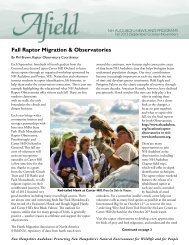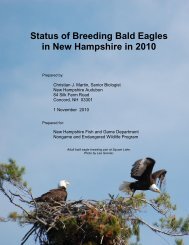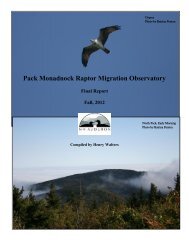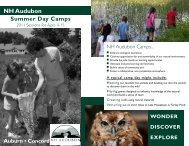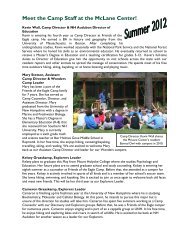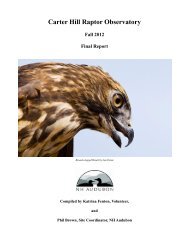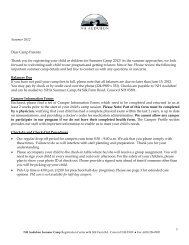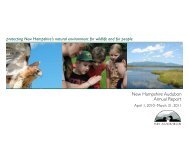The New Hampshire Dragonfly Survey: - New Hampshire Audubon
The New Hampshire Dragonfly Survey: - New Hampshire Audubon
The New Hampshire Dragonfly Survey: - New Hampshire Audubon
- No tags were found...
Create successful ePaper yourself
Turn your PDF publications into a flip-book with our unique Google optimized e-Paper software.
Background<strong>The</strong> insect order Odonata comprises the dragonflies and damselflies, and containsroughly 6000 species worldwide and 450 in North America north of Mexico. Dragonflies anddamselflies spend most of their lives (usually 1-3 years) as aquatic larvae, occupying allfreshwater habitats from small streams and seeps to large lakes and rivers, with a handful ofspecies also found in brackish or saline environments. Larvae undergo an incompletemetamorphosis into flying adults that live for up to two months. At all life stages, odonates areexclusively predatory, preying on other arthropods or small aquatic vertebrates.People have been documenting the Odonata of <strong>New</strong> <strong>Hampshire</strong> since at least the mid-19 thcentury, when the relative ease of accessing northern habitats in the White Mountains drewentomologists from as far away as Philadelphia. Data from roughly a century of collecting wascompiled in the early 1970s in the first published overview of the distributions of dragonflies anddamselflies in the state (White and Morse 1973). This publication listed 134 species as occurringin the state, 23 of these noted for the first time by the authors. In the decades that followed,casual collecting continued, but it was not until the late 1990s that the first field guides made iteasier for amateur insect enthusiasts to identify Odonata. <strong>The</strong> result was a surge of new recordsfrom 2000-2006, and another 17 new species added to the state list. By the mid-2000s, a total of160 species had been recorded in <strong>New</strong> <strong>Hampshire</strong>. A database of all available records throughthe end of 2006 (Hunt, unpubl. data) contains over 11,700 records dating back into the 19 thcentury. <strong>The</strong>se data are included in species maps and informed presentation of flight period data(see Results).<strong>The</strong> NH Wildlife Action Plan identified invertebrates as a group in need of more detailedinformation that could inform conservation. Given the increased knowledge of Odonatadistributions in the state, but their absence from most considerations of conservation priorities(the exception being the State-Endangered Ringed Boghaunter, Williamsonia lintneri), NH<strong>Audubon</strong> and NH Fish and Game, with funding from State Wildlife Grants, undertook aconservation assessment of the order for <strong>New</strong> <strong>Hampshire</strong> (Hunt 2006). This assessmentcompiled data from NH and neighboring states in an attempt to determine which species and/orhabitats should be considered conservation priorities. <strong>The</strong> result was a list of 56 species in needof more detailed data, plus a general conclusion that odonates of large rivers, peatlands, andhigh-elevation lakes might be more sensitive to environmental change than those of otherhabitats.<strong>The</strong> <strong>New</strong> <strong>Hampshire</strong> <strong>Dragonfly</strong> <strong>Survey</strong> (NHDS) is a direct outgrowth of therecommendations made by Hunt (2006). Also funded by State Wildlife Grants, its three principalgoals were:1) Obtain better information on the distribution and abundance of Odonata of potentialconservation concern in <strong>New</strong> <strong>Hampshire</strong>,2) Collect data from poorly surveyed parts of the state, and3) Increase public awareness of dragonfly diversity and conservation.1



